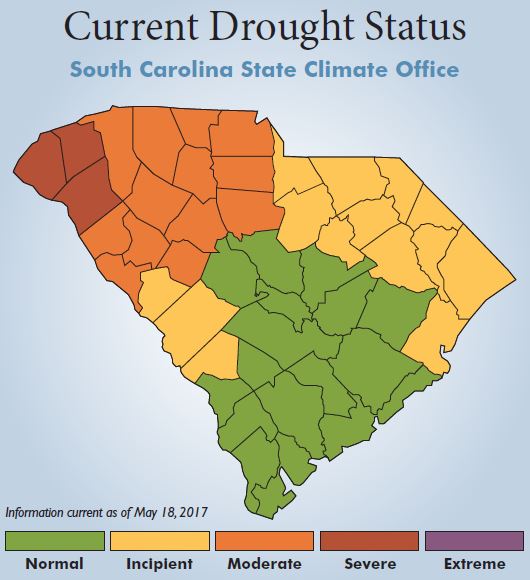It keeps us and our communities alive, clean, green and functional. But what happens when a city or town's water becomes scarce?
"Water is a shared resource that has to be fairly distributed to commercial, municipal and private use," said Wes Tyler, assistant state climatologist in the S.C. State Climatology Office, a division of the S.C. Department of Natural Resources, in April shortly before retiring. "Fire protection is a top priority, as is drinking water availability."

The S.C. Drought Response Act of 2000 requires that all water utility providers adopt a local drought management plan that addresses how water would be conserved during certain stages of drought — incipient, moderate, severe and extreme.
"Local drought ordinances or plans are the best-fit responses that address local hydrologic situations such as water supply source, distribution and usage," said Mark Malsick, severe weather liaison for the S.C. State Climatology Office.
A Drought Response Committee of state and local representatives from the state's four drought management zones periodically coordinates responses to water supply shortages. The committee decides if there is any level of drought in the state by reviewing average temperatures; precipitation; crop moisture index; future weather forecasts; and river flow, lake and groundwater levels.
Local drought management efforts are continually changing as conditions change, but not all plans work for each season. There is typically greater demand for water during the warmer months, but consumption can rise at any time of the year. Keeping the public involved, informed and participating in the decision-making process is key to implementing an effective drought management plan.
That's why it helps to get ahead of a drought when faced with a long-term forecast of scant rain. The S.C. Climatology Office recommends officials undertake predrought planning efforts.
Some preresponse measures aimed at conserving the system's source water include
Identifying all major water users of the system (the top 10 percent heaviest users, including wholesale customers).
Identifying water users with whom there are conservation agreements.
Conducting a vigorous public education program. An effective public outreach program will keep the public informed about the water supply situation, what actions will mitigate drought emergency problems, and how well the public is meeting the program goals.
"Between surface and ground water sources, our state is fortunate to be able to — so far — meet existing demands, sometimes with restrictions," Tyler said. "The wise practice of water storage along most of South Carolina's river systems has proven to ensure that demand is met."
How bad is it?
Incipient drought — There is a threat of drought. Water levels should be more closely monitored.
Moderate drought — The threat of a drought is increasing. Local water provider can begin seeking voluntary reductions from consumers in their use of water during peak water-demand periods. Typically, the local provider aims to cut usage by 15 percent.
Severe drought — The local provider seeks voluntary reduction in water usage and can impose mandatory restrictions on nonessential usage. These restrictions, with a goal to achieve a 20 percent reduction of water usage, could involve staggering the use of water for irrigation, eliminating the washing of sidewalks and buildings, putting a halt to installations of new irrigations taps on the water system and barring consumers from washing their vehicles at home.
The provider would also emphasize to the public that consumers must conserve. When communicating potential restrictions, local officials should stress the cost savings of water conservation measures, said Malsick.
Cutting back on water usage for a given period of time is better than the alternative in many ways.
"Building water distribution infrastructure is a very expensive solution to assuage water shortages during periods of drought," Malsick said. For example, if a city or town runs out of water, trucking water in is very costly, while building water pipelines is even more so.
Extreme drought — Certain indices show a water supply shortage exists and is expected to persist. The provider aims to cut water usage by 25 percent. Customers can be mandated to eliminate any irrigation, filling swimming pools, washing vehicles, and other nonessential uses of water.
Additionally, officials could continue to stop installation of new irrigation taps on the water system; place a moratorium on the issuance of all new water service connections and contracts for all new water main extensions; or impose a drought surcharge per 1,000 gallons of water, a fee that increases with higher usage. The general principle behind the drought surcharge is that the fee is imposed on water use in excess of normal use.
As with other natural disasters and special circumstances, the governor wields emergency powers. If the Drought Response Committee finds that the conditions in a drought management area have worsened to the point of jeopardizing the health and safety of the public, the committee reports the conditions to the governor and provides a priority list of recommended actions designed to alleviate the effects of drought conditions. The governor may declare a drought emergency and issue emergency regulations to require a moratorium on water withdrawals or to allocate water on an equitable basis.
Refer to each local ordinance or plan for a more complete list of management practices and conservations measures. A model ordinance is also available.
